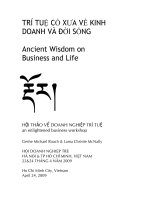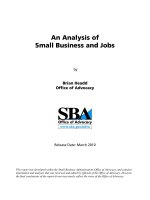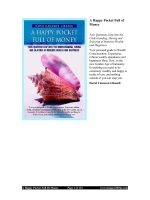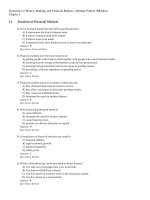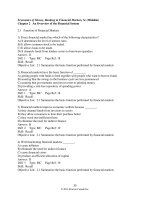Enough true masures of money business and life
Bạn đang xem bản rút gọn của tài liệu. Xem và tải ngay bản đầy đủ của tài liệu tại đây (1.79 MB, 232 trang )
robin-bobin
cover
title :
author
publisher
isbn10 | asin
print isbn13
ebook isbn13
language
subject
publication date
lcc
ddc
subject
:
:
:
:
:
:
:
:
:
:
next page >
Dance Lessons : Six Steps to Great Partnerships in
Business & Life
Bell, Chip R.; Shea, Heather
Berrett Koehler
1576750434
9781576750438
9781583763124
English
Partnership.
1998
HD69.S8B453 1998eb
650.1/3
Partnership.
cover
next page >
robin-bobin
< previous page
page_i
next page >
Page i
Dance Lessons
< previous page
page_i
next page >
robin-bobin
< previous page
page_ii
next page >
Page ii
ALSO BY
Chip R. Bell
MANAGERS AS MENTORS
Building Partnerships for Learning
CUSTOMERS AS PARTNERS
Building Relationships That Last
INFLUENCING
Marketing the Ideas That Matter
Chip R. Bell and Ron Zemke
MANAGING KNOCK YOUR SOCKS OFF SERVICE
SERVICE WISDOM
Creating and Maintaining the Customer Service Edge
Chip R. Bell and Fredric Margolis
UNDERSTANDING TRAINING
Perspectives and Practices
INSTRUCTING FOR RESULTS
Chip R. Bell, Ray Bard, Leslie Stephen, and Linda Webster
THE TRAINER'S PROFESSIONAL DEVELOPMENT HANDBOOK
Chip R. Bell and Leonard Nadler
CLIENTS AND CONSULTANTS
Meeting and Exceeding Expectations
THE CLIENT-CONSULTANT HANDBOOK
< previous page
page_ii
next page >
robin-bobin
< previous page
page_iii
next page >
Page iii
Dance Lessons
Six Steps to Great Partnerships in Business & Life
Chip R. Bell
Heather Shea
Foreword by Tom Peters
< previous page
page_iii
next page >
robin-bobin
< previous page
page_iv
next page >
Page iv
Copyright © 1998 Chip R. Bell and Heather Shea
All rights reserved. No part of this publication may be reproduced, distributed, or transmitted in any form or by any
means, including photocopying, recording, or other electronic or mechanical methods, without the prior written
permission of the publisher, except in the case of brief quotations embodied in critical reviews and certain other
noncommercial uses permitted by copyright law. For permission requests, write to the publisher, addressed
"Attention: Permissions Coordinator," at the address below.
Dance LessonsSM is a service mark of Chip R. Bell and Heather Shea
Berrett-Koehler Publishers, Inc.
450 Sansome Street, Suite 1200
San Francisco, CA 94111-3320
Tel: (415) 288-0260 Fax: (415) 362-2512 www.bkpub.com
ORDERING INFORMATION
Individual sales. Berrett-Koehler publications are available through most bookstores. They can also be ordered direct
from Berrett-Koehler at the address above.
Quantity sales. Special discounts are available for quantity purchases by corporations, associations, and others. For
details, contact the "Special Sales Department" at the Berrett-Koehler address above.
Orders for college textbook/course adoption use. Please contact Berrett-Koehler at the address above.
Orders by U.S. trade bookstores and wholesalers. Please contact Publishers Group West, 1700 Fourth Street,
Berkeley, CA 94710. Tel: (510) 528-1444; Fax: (510) 528-3444.
Printed in the United States of America
Printed on acid-free and recycled paper that is composed of 85% recovered fiber, including 15% post consumer
waste.
Library of Congress Cataloging-in-Publication Data
Bell, Chip R.
Dance lessons : six steps to great partnerships in business and
life / Chip R. Bell, Heather Shea: foreword by Tom Peters.
p. cm.
Includes bibliographical references and index.
ISBN 1-57675-043-4 (alk. paper)
1. Partnership. I. Shea, Heather. II. Title.
HD69.S88453 1998
650.1'3-dc21
98-27938
A STEPHENPUSTEJOVSKY Book Austin, Texas
Executive editor. Leshe Stephen Art direction/text and lacket design: Suzanne Pustejovsky Copyediting: Jeff Morns
Proofreading: Deborah Costenbader and Jamie Fuller Index: Joanne E. Clendenen Composition/production: Round
Rock Graphics Cover photo: Cheryl Maeder/FPG International LLC Step One photo: Mark Scott/FPG Internauonal
LLC; Step Two Photo: SuperStock Inc., Step Three photo: Telegraph Colour Library/FPG International LLC, Step
Four photo: Cheryl Maeder/FPG International LLC, Step Five photo: Patti Bose Photographics, Orlando, FL; and
Step Six photo: Patti Bose Photographics, Orlando, FL.
First Edition 04 03 02 01 00 99 98 10 9 8 7 6 5 4 3 2 1
< previous page
page_iv
next page >
robin-bobin
< previous page
page_v
next page >
Page v
Dedicated to
Nancy Rainey Bell
and
Yvonne Luke Gubner
< previous page
page_v
next page >
robin-bobin
< previous page
page_vii
next page >
Page vii
CONTENTS
Foreword
by Tom Peters
ix
Preface
xiii
Thanks
xix
Introduction: Shall We Dance?
1
Step One
Focusing: Preparing for Partnership
12
Lesson 1. Choosing the Right Partnership for the Right Reasons
25
Lesson 2. Understanding What Makes a Great Partnership
33
Step Two
Auditioning: Picking Great Partners
42
Lesson 3. What Makes a Great Partner?
53
Lesson 4. Conducting a Partnership Test: The Virtual Audition
61
Lesson 5. A Partnership Test: The Eleven-Point Checklist
75
Step Three
Rehearsing: Getting the Partnership in Shape
82
Lesson 6. The Conditions of Conditioning
89
Lesson 7. Blocking Out Your Performance Together
101
Lesson 8. Three Partnering Drills
113
< previous page
page_vii
next page >
robin-bobin
< previous page
page_viii
next page >
Page viii
Step Four
Dancing: Keeping the Magic in Motion
124
Lesson 9. Using Your Heart to Keep Great Partnerships Great
129
Lesson 10. Using Your Head to Keep Great Partnerships Great
137
Step Five
Hurting: Managing the Pain in Partnership
142
Lesson 11. What to Do When You Trip Up
149
Lesson 12. Coping with Pain That's Not Your Fault
159
Step Six
Bowing Out: Calling It Curtains
170
Lesson 13. Ending a Partnership That Flopped
175
Lesson 14. Ending a Partnership That Worked
185
The Final Lesson: Promenade Home
195
Notes
197
Sources
199
Authors
205
Index
207
< previous page
page_viii
next page >
robin-bobin
< previous page
page_ix
next page >
Page ix
FOREWORD
by Tom Peters
You don't have to be a good dancer to be a good partner. Fact is, you don't have to know how to dance at all . . .
except metaphorically speaking.
I've often said that I'm nuts about a good metaphor. Because in these traumatic, wild and woolly, topsy-turvy times,
this age of brainware, creativity, paradox, unreason . . . pick your favorite expression . . . unforgettable wordpictures are our most practical guides, our real-life strategic plans for thriving in this chaos. And Chip Bell and
Heather Shea have a vision of partnership that's exactly right for these turbulent times. Just like modern jazz or
theater . . . or some of our well-worn sports analogies . . . dancing gives us a fast and lasting image of how the BIW
(best-in-world) partnerships work.
< previous page
page_ix
next page >
robin-bobin
< previous page
page_x
next page >
Page x
And who needs this partnership-as-a-dance stuff? Everybody, and I mean E-V-E-R-Y-B-O-D-Y. Unless you've been
out of this world for the last 10 or 15 years, you know that we've said bye-bye to organizations-as-we've-knownthem-for-the-last-250 (or so)-years. You know that the most successful "organizations" today are ever-shifting,
temporaryor, at most, semi-permanentstrategic alliances, formed to exploit some (probably fleeting) opportunity in
the marketplace.
Think about any great dance partnership . . . Rogers and Astaire, Kelly and O'Connor, Fonteyn and Nureyev . . .
what's going on there? what went into those standing-ovation results? Years of hard work, practice, basic
training . . . well, sure. Plus originality, personal chemistry, everlasting experimentation, constant innovation,
trust . . . even more important. Oh, yeah . . . and passion.
BIW strategic alliances are just like that . . . a special blending of brain and muscle, heart and soul, passion and
persistence that come from the PEOPLE in the relationship. Doesn't matter whether we're talking about Motorola's
global supplier-producer relations or the next project you're doing with those folks down the hall. Commitment,
compatibility, information sharing, a passion for precision execution, trust . . . all that soft stuff . . . that's what
makes those partnerships great. And . . . I've said this over and over, and I'll say it again . . . there's no excuse for not
being great.
So, no need to trot the leg-warmers out of mothballs. Just fire up the synapses that spark IMAGINATION and
INNOVATION in your brain, and get ready for a real workout. This stuff takes (lots of) effort . . . but it's worth
itjust think about your marriage or your closest friendships.
< previous page
page_x
next page >
robin-bobin
< previous page
page_xi
next page >
Page xi
BIW partners themselveswith one another and with countless others (including yours truly at one time or another)
Chip and Heather really know the score about how to make and keep a partnership GREAT.
And . . . I'll say it one more time . . . there's no excuse for not being great. Do what they say, and your next
partnership will be.
TOM PETERS
PALO ALTO, CALIFORNIA
JULY 1998
< previous page
page_xi
next page >
robin-bobin
< previous page
page_xiii
next page >
Page xiii
PREFACE
''I think the reason dance has held such an ageless magic for the world is
that it has been the symbol of the performance of living."
Martha Graham
Listen to the sounds of partnership played out on two very different stages.
Setting: The Dance Stage
"We merged at some point . . . like we were one! The first few steps were a bit shaky, we thought later.
The audience probably never noticed. We sure did! But at some point when the orchestra seemed to hit its
stride, we were there. We were hot. It was pure, totally pure."
Setting: The Conference Room
"We seemed to really click! We've found some terrific synergy. To be frank, it was touch and go right out
of the starting block. But once we were up to full speed on our first joint project, we found the groove
quickly. Everything fell into place. It's been a success on all sides."
The ability to develop and maintain productive partnerships is the critical success factor in today's world. Yet it is
the art, not the science, of a partnership that determines its success. Whether that collective enterprise is a powerful
corporate alliance, an award-
< previous page
page_xiii
next page >
robin-bobin
< previous page
page_xiv
next page >
Page xiv
winning dance team, or a loving marriage, the true artists of partnering know it is the heart and soul of the alliance
that keep it going despite occasional missteps and setbacks.
No art form more easily captures what goes on in a great partnership than dance. When we think musician, sculptor,
or painter, "solo" races to the front of our mind. But mention partnership as a dance and we instantly "get" the
imagery; the analogy is clear and compelling. Partnership is a danceone that can make your feet sore while it lets
your heart soar!
This book is about making partnerships greatnot just satisfactory, not just adequate, not just okay. If you picked this
book up hoping to learn about the methods and mechanics of structuring corporate alliances, please put it back and
select another. If you got here hoping for a pragmatic primer on the legal, financial, or technical components of the
coalitions of commerce, you will probably be disappointed. All those ingredientslegal and financial, technical and
mechanicalare important. However, they all hang by strings attached to the heart and soul of the union.
This book is also about making everyday partnerships great. We talk far more about partnerships having to do with
the cubicle across the aisle, the department down the hall, or the merchant down the streeteveryday partnershipsthan
those global, mega-strategic alliances crafted in boardrooms or ornate offices on mahogany row. We are thinking of
the key vendor with whom you need a deeper bond, the important customer with whom you seek a mutual covenant,
or a valued friendship that is ready for a richer union. Partnerships are everywhere, every way and every day. Many
are in despair, some are fair, and great ones are rare. This book is the treasure map for your pursuit of high-quality
alliances.
We promise a robust review of what makes partnering a powerful and exhilarating dance. In our research on
partnership
< previous page
page_xiv
next page >
robin-bobin
< previous page
page_xv
next page >
Page xv
success, we interviewed a wide range of people currently participating in great partnerships. The metaphor of dance
enabled usand them!not only to gain fresh perspectives on what makes partnerships work well but also to tap an
unconventional source of insight and inspiration.
We are hopeful that as you read this book you will learn a lot about great partnerships and maybe even a little about
great dancing! We are confident you will gain useful information and fresh insights on how to
decide if partnership is right for you,
select the right form of partnership,
get ready to partner,
pick good partners,
practice effective partnering,
deal with difficult partners and partnerships,
know when the partnership is ready to end,
manage the factors that lead to partnership greatness, and
keep learning about great parmering.
Partnerships are becoming more important and more complex as the driving coalitions of commerce. Organizations
and units seek to partner with vendors, unions, competitors, and customers. Outsourcing ancillary functions
produces special opportunities best capitalized on with partnership tools. Teams succeed because of interpersonal
forming-storming-norming-performing abilities, not because of talent, tactics, or strategy. Successful teams, units,
and organizations are dropping hierarchical, authority-driven structures in favor of nimble confedera-
< previous page
page_xv
next page >
robin-bobin
< previous page
page_xvi
next page >
Page xvi
tions better suited for the rapid and agile mobilization of talent. All these alliances rise and fall based far less on the
soundness of their settlements and far more on the success of their synergy.
Partnering is on the rise. But "partnership" can mean many things. It can imply the temporariness of the person
sitting across the bridge table or the longevity of the person lying beside you in a marriage. The relationship can be
as intense as the one you have with your associate in a boardroom and as friendly as the target of your "Howdy!" in
a Texas barroom.
There are likewise multiple prescriptions for partnership success. One absolute is this: partnerships are far too
complicated for easy instructions. With that in mind, we offer both "stage directions" and an early warning. Our
directions on partnership greatness are not presented as lockstep rules; our fourteen lessons were constructed with
the idea that you would need to do a fair amount of "adjust to fit." Our early warning is this: it isn't the stage
manager's great directions that have the audience shouting "Encore!'' after a great finale, so don't get so wrapped up
in our instructions that you forget to use your own head and heart.
Partnerships are forever becoming and never complete. Like great dances, great partnerships are never perfectthere
is always another lesson to be learned, another routine to be practiced. As dancer and choreographer Gene Columbus
says, "A dance is a pursuit. You never call yourself the best because you are always striving to be better." Solid
partnerships will continually heed their own special version of ". . . five, six, seven, eight!" They know that, at some
level, rehearsals never end. This is the manual for that perpetual pursuit of mastery.
We want you to get the absolute most from this book. We hope you will want to read all the words rather than just
scan some of them. Dance Lessons was assembled like a dancer's notebook. There are the formal lessonsthe
instructions and
< previous page
page_xvi
next page >
robin-bobin
< previous page
page_xvii
next page >
Page xvii
directionsto be sure, but you will also see tips and quips, models and metaphors drawn from our imaginations and
from very real stories in the world of business and the world of dance. Together they make a complete picture of
partnership greatness. If you examine only certain parts, you may draw incomplete conclusions. While you are
obviously free to read what you like, we encourage you to read all the pieces, in sequence.
Make these "dance lessons" come alive! Reading this book without thinking about how it applies to your situation
denies you the pragmatism we intend and the practical support you may need. Before reading the book, identify a
relationship you seek to develop into a partnership, an alliance you wish to improve, a skill you want to enhance, or
a partnership problem you want to solve. While you read, make notes on how you might apply the techniques you
find. Another approach might be to make this book the text for a review of an existing partnership. Each of you
might read a section independently and then meet to explore its implications for your partnership.
Share this book with all your "dance partners"your colleagues, associates, vendors, customers, suppliers,
stakeholders. This book doesn't contain secrets aimed at making you look good to an unwitting partner. The more
you know about how to partner, the more likely all your relationships will be great. The same is true for your
partners.
We hope you enjoy Dance Lessons! And we would like your feedback on its usefulness as well as your ideas on
ways it might be improved in future editions. You will find our address at the bottom of the last page of the book.
Drop us a line, fax, or email note, or give us a call. In the meantime, break a leg!
CHIP R. BELL
DALLAS, TEXAS
HEATHER SHEA
ORLANDO, FLORIDA
JULY 1998
< previous page
page_xvii
next page >
robin-bobin
< previous page
page_xix
next page >
Page xix
THANKS
Few activities are more interdependent than writing a book. While the image of a recluse writer pounding a
keyboard is the "author picture" in most people's heads, a published book reflects the collective efforts of many.
These are the pages we use to say "thank you" to the many people who joined us in this demanding but jubilant
dance.
Three teams worked with us on Dance Lessons. The Texas production team was headed by Leslie Stephen in Austin.
The look of the book was crafted by an extraordinarily creative art director, Suzanne Pustejovsky. World-class editor
Jeff Morris fashioned the sound of the book. And Leslie delivered a stunning performance as leader, coach,
cheerleader, worrier, fixer, and inspirer in her nonstop commitment to making this book a showstopper.
The California publishing team was led by Steve Piersanti, president of Berrett-Koehler Publishers, whose entire
staff reflects a commitment to great partnerships in business and life. With marketing director Pat Anderson and
production director Elizabeth Swenson, Steve remained steadfast in the quest to
< previous page
page_xix
next page >
robin-bobin
< previous page
page_xx
next page >
Page xx
facilitate depth, meaning, and significance from a book that began as a random collection of note cards!
The crack research and business-and-life team of Debbie and Cliff Dickinson in Orlando put in yeoman effort doing
countless hours of partner interviews. They helped us discover important learnings from their reams of transcripts.
We are also grateful to the people who reviewed early drafts of the manuscript and gave us valuable feedback for
sharpening it up: Chris Clarke-Epstein, Gabriela Melano, Randy Kosinski, and Victoria Spoor.
We also give a special thanks for the great insights we got from choreographer Gene Columbus, manager of
entertainment staffing at Walt Disney World Entertainment.
The coaching of Chip's business partners, Ron Zemke and Tom Connellan of Performance Research Associates,
helped bring real-life relevance to the book. The music of Larry Gatlin and The Gaithers (Bill, Gloria, and friends)
provided inspirational connection to the muses during the writing process. A world of thanks from Heather to Tom
Peters and Ben Vereen for believing in her and encouraging her to live her dream and to David Mulvey and Elaine
Burns for caring for her and the next generation of dancers. We are especially grateful to Valerie Oberle for her
work with Heather that sparked the original idea for the book, and we are indebted to our family, friends, colleagues,
and clients for the countless lessons we have learned from them over the years about great partnerships.
Finally, this book would not have happened without the emotional support and endless love of our families: Nancy
Rainey Bell, Bilijack Bell, Bianca Shea, Portia Shea, Judy Terry, and Richard Gubner.
To all of you . . . a heartfelt thanks.
< previous page
page_xx
next page >
robin-bobin
< previous page
page_1
next page >
Page 1
INTRODUCTION
SHALL WE DANCE?
The conference room was an "auditorium" of pure energy! The leader of a large engineering firm was engrossed in
an intense exchange on marketing strategy with the leader of a manufacturing company. Their partnership, now six
months old, bad taken on a show-stopping synergy neither bad expected. Associates from each organization entered
and exited as if performing a well-rehearsed script. Yet this latest project was a brand-new joint venture.
Almost completing each others' sentences, the two leaders shifted from thorny discord to affirming harmony. They
"danced" their way to resolution, agreement, and commitment. When they concluded their discussion and stood to
shake hands, their associates spontaneously broke into loud applause. As if on a real stage, the two turned toward
the crowd and jokingly bowed to their fans.
< previous page
page_1
next page >
robin-bobin
page_2
< previous page
next page >
Page 2
The world of enterprise is already teeming with the sounds of partnership. Visit your local bookstore and you may
be surprised at the large number of books with "partnership" in their titles or subtitles. Countless organizations tout
the concept of "partnering" in their ads or PR pap. Most successful business units and organizations report they have
been inundated with requests from others that "we get together and explore how we might form an alliance.'' Yet far
more partnerships fail than succeed.
Those enterprises and entities that succeed do so because they have a clear sense of the requirements for great
partnering. Those that bring the house down at curtain call are those that never stop rehearsing, even after a stream
of great reviews and standing ovations. They have to dance, they know how to dance, they keep "taking lessons" to
perpetually stay at the top of their dance . . . and they love to dance. Partnership is the dance of the new millennium.
Partnership: The Work Version of Marriage
We define "partnership" as "a deliberate blending of capacities for the continuous mutual benefit of involved
parties."
"Partnership is not the paperwork, it is the human dimension."
Pat Heim,
author of Hardball for Women
Let's look at the key parts of that definition. First, partnerships must be "continuous" . . . they dance until the music
stops. This means that partnerships have a momentum; each encounter has a tie back to the last. Some partnerships
have only a few encounters; some go on for many years. We do
< previous page
page_2
next page >
robin-bobin
< previous page
page_3
next page >
Page 3
not assume partnerships must have a "forever" intention to qualifythat's a marriage. On the flip side, if the
relationship is likely to be a single encounter it fails to qualify. Single-encounter relationships are transactionslike
the mechanic at the repair shop, the receptionist at the dentista solitary shuffle-hop-step. We generally want such
transactions to be agile, able, and amiable, not intimate, intense, and interdependent.
Partnerships are "a blending of capacities." "Blend" implies a mixture, not necessarily equal parts. It also implies a
kind of worked-out amalgamation of shared assets. "Capacities" is our word for the array of ''stuff" that partners
might bring to the relationship. That stuff could be information, good will, capital, or other resources.
"Partnership is like intertwining threads . . . together they make a rope."
Louise Lague,
The Wisdom Group
"Mutual benefit" means that all parts of the partnership must derive adequate gain from the relationship. While
reciprocity is a requirement, perfect balance is a momentary occurrence and not an everlasting prerequisite.
Relationships with the benefits all weighted to one side are relationships based on dependence; the one-sidedness in
time becomes a parasitic arrangement as the giver gets weaker and more angry, the taker stronger and more selfish.
In time, the connection collapses under its own dysfunction.
"Deliberate" and "involved parties" both strongly communicate that partnerships entail assertive effort. While we
believe partnerships can be formed by accident, we do not believe they can be maintained by accident.
But partnership is more than a word to be defined in a book. "It is a process, not a transaction," Terry McElroy,
senior vice president of McLane Company, reminds us. "Partnership is the work version of marriage," says Marcia
Corbett, vice president of marketing for AchieveGlobal, "not in the sense of permanence, but certainly in the sense
of depth, commitment, and loyalty. It is born out of an honest realization that you have needs and goals you cannot
meet or maximize without a partner."
< previous page
page_3
next page >
robin-bobin
page_4
< previous page
next page >
Page 4
These definitions and descriptions inform us that partnerships are both potent and pervasive. When you invite a
colleague to be an ongoing sounding board for your ideas, in exchange for your keeping an eye out for assignments
for which she might be qualified, you are partnering. When you offer a key vendor special status with the
expectation that he will bring you his best solutions first, you are partnering. When you agree with your significant
other that you will do all the housework, feed the "livestock," and wash the car in exchange for pot roast on Friday
night, you are partnering (not particularly wisely, in our opinion, but reciprocity is in the eye of the beholder).
Partnerships are everywhere, in countless ordinary interpersonal associations. Given how much time we invest in
them, when we improve our partnerships, we improve our lives.
"Partnership is the work version of marriage."
Marcia Corbett,
AchieveGlobal
Dance: The Landscape of the Soul
It is said that great dancers learn their steps so they can forget them. They practice to a point they can simply hear
the music and move. Great partnerships also reach a point of such intuitive oneness that they can operate with
magical harmony and stunning grace. However, as in dance, the path to greatness takes deliberate steps, each
practiced with care, commitment, and consistency. Dance Lessons is an instruction manual for stepping to greatness.
The wisdom and warnings we share with you in Dance Lessons came through in-depth interviews with a wide range
of people highly experienced in great partnerships. Their organizations were as mainstream as Marriott, as niche as
USAA, and as avant-garde as the Broker Restaurants. Some were well known, like the Disney Institute; some were
new partnerships, like AchieveGlobal, an alliance originally made up of three famous training companies.
< previous page
page_4
next page >
robin-bobin
< previous page
page_5
next page >
Page 5
Our interviews predictably confirmed much we already knew. Great partnerships are populated by partners who
conduct their selection process very carefully. They have clear goals and worked-out-in-advance cues. They take the
time to explore how they plan to end the dance before they take to the floor. They are relationships that exhibit as
much passion as discipline; they are as emotional as they are rational.
Our interviews also gave us some unanticipated insights. We discovered that the steps toward greatness are precise
and consistent. So, using dance as our metaphor, we constructed our text around the six steps we heard described
repeatedly in our interviews. We also learned that great partnerships spend far, far more time getting ready to partner
than we expected. For that reason, the partnership itselfwe call it "dancing"doesn't begin until our Step Four! Steps
One through Three all focus on getting ready for the main event.
One additional unexpected discovery. Great partners all talk about having the same core commitmentswe call them
protocols. A protocol is a no-need-to-explain kind of routine that partners accept, value, and depend on. Chess
players don't have to decide on the moves a pawn is allowed; football players don't argue over how many points a
touchdown is worth. While our interviewees used vastly different words to describe what goes on in a great
partnership, we found the same protocols operating in all of them.
We learned that great partnerships begin their relationship expecting the best from it. This standard not only serves
as a criterion for achievement, it provides a noticeable self-fulfilling optimism. Partners work diligently to always
assert the truth. This proactive gesture keeps integrity at the forefront of all their dealings. Consistent with this value
is a focus on perpetually keeping agreements, ensuring that the partnership is filled with trust and commitment.
"Partnership may be a legal term, but it is fundamentally not a legal
concept. Bottom line, it is two or more people serving the relationship by
serving each other."
John Campbell,
Brookfield Management Services
Great partners are always quick to honor their partner. By lacing the relationship with deep respect and noticeable
admi-
< previous page
page_5
next page >
robin-bobin
page_6
< previous page
next page >
Page 6
ration, the partners achieve more without wasting energy on suspicion. They place enormous emphasis on having
passionate connectionswe call it being all, theremeaning that great partners bring all they have to every encounter.
Finally, the resilience and allegiance they bring to their collective mission form a protocol we label stay . . . on
purpose.
"Dance is the landscape of the soul."
Martha Graham
While we will explore these protocols in depth in Step Three: Rehearsing, we refer to them throughout the book as
the underpinnings of each step to partnership greatness.
Six Steps to Greatness
Our concept of a partnership dance has six steps for success: Focusing, Auditioning, Rehearsing, Dancing, Hurting,
and Bowing Out. Within each step are two or three lessons. The lessons detail the basic choreography of partnership
as well as offer various "bite-size" tips and techniques for your review, reflection, and practice. To help you zero in
on how to use what is to come, here is a brief description of the objective of each step.
Step One
Focusing: Preparing to Partner
Dancing is a method of expressing a much deeper purpose than the mere movement of feet and limbs, torso and
head. Great dancers would be great painters if their talents lay in that direction. It is the intense focus on excellent
creative expression that fuels the dancer, not the dance itself. As relationship dances, partnerships must be grounded
in a clear commitment to some purpose that can best be expressed through a partnership. Partners who partner for
partnering's sake stop dancing long before the music stops. Before choosing your "footwork," you must focus deep
inside to find the common purpose that will inspire you to partnership greatness.
< previous page
page_6
next page >
robin-bobin
page_7
< previous page
next page >
Page 7
Step Two
Auditioning: Picking Great Partners
As an early test to ensure good partnership fit, auditions are all about discovery and disclosure. They are the method
great partnerships use not only to identify their special talents, but also to create a setting for learning and
communicating expectations. This step will delve into an assortment of "starting" issues important to choosing the
right partner; it will also tell you how to craft the cues that can offer an early warning to postpone or cancel the
dance before your investment in the partnership makes "calling it curtains" awkward.
Step Three
Rehearsing: Getting the Partnership in Shape
Most masters of partnerships warn that the early stages of a relationship are the most critical. Choreographing the
relationship involves identifying all the important first steps and walking through them deliberately, shutting out any
distractions. Naysayers speak loudest in the opening scenes, when the partnership is most vulnerable given the
newness of the dance. Your early focus should be on "working the plan," ignoring any opposition or objections.
Great dancers use rehearsal time to focus on their feet and dance the steps. This section will offer tips for effective
"foot watching."
"Partnerships are hard work. It's not occasional cigars and cognac . . . it is
working hard at itall the time."
Michael Metzler,
Metzler & Company
Step Four
Dancing: Keeping the Magic in Motion
Step Four is all about finding and keeping the feel or flow of the dance. Hear the message here: dancing is our fourth
step, not the first. Preparation is paramount for great performances. Partnerships are greatness in the making. They
are hopeful pursuits of magic, not efforts valued only at the finale. While there is no sure-fire, secret formula for
everlasting partnership progress, we describe the many ways great partnerships consciously keep going and growing.
< previous page
page_7
next page >
